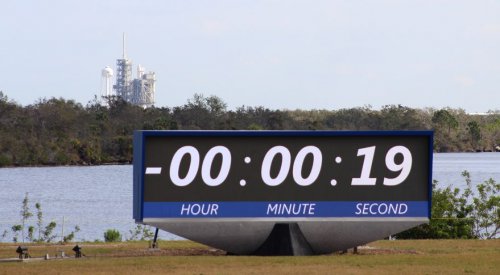KENNEDY SPACE CENTER, Fla. — The first launch by SpaceX from an historic launch pad here will be delayed by at least a day after a technical problem scrubbed an attempted launch of a Dragon cargo spacecraft Feb. 18.
Launch was scheduled from Launch Complex 39A at 10:01 am Eastern but controllers halted the countdown 13 seconds before liftoff when they were not able to resolve a problem with the thrust vector control system on the rocket’s upper stage. That system is used to position the nozzle of the stage’s single engine.
“All systems go, except the movement trace of an upper stage engine steering hydraulic piston was slightly odd. Standing down to investigate,” SpaceX Chief Executive Elon Musk tweeted shortly after the countdown was halted.
With an instantaneous launch window, the halt in the countdown scrubbed the launch for the day. SpaceX and NASA said they are planning the next launch attempt for 9:38:59 a.m. Eastern Feb. 19.
The Dragon, flying a mission designated SpX-10 by NASA and CRS-10 by SpaceX, is carrying 2,490 kilograms of cargo for the ISS. The bulk of the Dragon’s payload are experiments and instruments, including several Earth science sensors and technology demonstrations carried in the Dragon’s external trunk that will later be mounted on the station’s exterior. Less than 300 kilograms of cargo is devoted to crew supplies.
“We’ve got well above our reserve levels of food and water, so we’ve really dedicated this Dragon mission to the research,” said Dan Hartman, deputy manager of the ISS program at NASA, at a Feb. 17 pre-launch press conference.
The launch will be the the first from LC-39A since the space shuttle Atlantis lifted off on the final space shuttle mission, STS-135, in July 2011. NASA leased the pad to SpaceX in 2014, who converted the pad originally for use for crewed launches of the Falcon 9 as well as its upcoming heavy-lift vehicle, the Falcon Heavy.
SpaceX, though, has pressed the pad into use for other Falcon 9 missions after an explosion during preparations for a static-fire test Sept. 1 damaged the company’s other Florida pad, Space Launch Complex 40 at Cape Canaveral Air Force Station.
“It’s a historic pad, and we’ve taken good care of it during the refurbishment and the rebuild,” SpaceX President Gwynne Shotwell said at a Feb. 17 press conference adjacent to LC-39A.
Using LC-39A allowed SpaceX to resume Florida launches, including ISS and commercial satellite missions, sooner than if they had to wait for repairs at SLC-40 to be competed. “Frankly, the fact that we were this close to operations on 39A when we had the event on Sept. 1 of last year was enormously helpful,” she said. “It obviously takes longer to rebuild that pad than to get this one up and running.”
- SpaceX ready for first launch from historic KSC pad
- Countdown underway for launch of more than 100 satellites on an Indian Polar Satellite Launch Vehicle
- SpaceX planning Feb. 18 launch of cargo spacecraft on first mission from historic launch pad
- SpaceX launch will be last to dispose of rocket’s first stage
- Progress launch to space station fails
Share with your friends

(0) Comments
This article comments are currently no :(